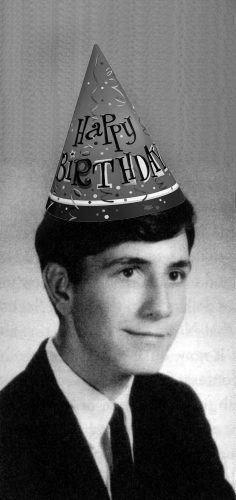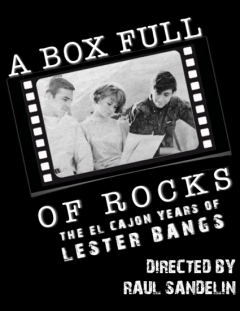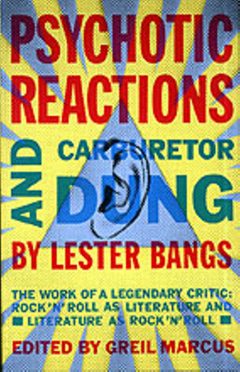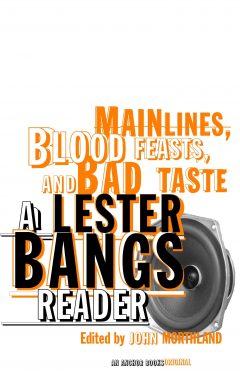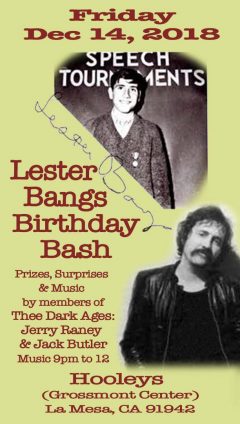Featured Stories
Lester Bangs’ 70th Birthday Bash: Whatever happened to “Don’t trust anyone over 30?”
The other night I dreamt of knives
continental drift divide
Mountains sit in a line, Leonard Bernstein,
Leonid Brezhnev, Lenny Bruce, and Lester Bangs…
–REM, “It’s the End of the World as We Know It”
So you have this brilliant writer. Sure, he has some problems. He has problems with the bottle and some chemical dependencies. Most certainly, the writer is no role model for today’s youth and dies young himself due to his own choices, vices, and bad habits. However, the writer is internationally read and much beloved. So what does his hometown do? Well, if you’re the city of Baltimore, you name your NFL football team “the Ravens.” Yes, I was talking about Edgar Allan Poe. What? You thought I was talking about Lester Bangs?
When El Cajon, California gets its own NFL franchise, I have faith that the team will be named after Lester Bangs (the El Cajon Bangers has a nice ring to it). Until then, we have to resort to other means to honor the writer who is arguably El Cajon’s greatest contributor to the literary world.
So when in doubt, we can throw Lester a birthday party. After all, this year would mark his 70th. And that’s exactly what’s happening at Hooleys Grossmont Center on Friday, December 14, Lester’s actual birthday: the first annual Lester Bangs Birthday Bash!
Actually, a lot has been happening, both here in Lester’s hometown and internationally, to honor, to quote Jim Derogatis, “America’s greatest rock critic.”
Beginning in the 1980s, it was obvious that Lester’s writing deserved serious literary treatment and the first collection of his work, Psychotic Reactions and Carburetor Dung, was released. This anthology was edited by legendary rock writer Greil Marcus. In 2002 a second collection, Main Lines, Blood Feasts, and Bad Taste: A Lester Bangs Reader, edited by the late John Morthland was published. Along the way, articles and zines have been written, from 1990’s Throat Culture to articles by Lester’s childhood friends Rob Houghton and Gary Rachac. Mike Stax’s Ugly Things magazine has also helped keep the Lester Bangs flame alive.
Most famously, Lester Bangs’s hovering spirit helped garner an Oscar for Cameron Crowe, who relied on his own teenage memories of Lester Bangs when he penned the screenplay to Almost Famous in 2000. Also in that year, Jim Derogatis’ momentous biography, Let It Blurt: The Life and Times of Lester Bangs, America’s Greatest Rock Critic, was published.
Locally, Lester’s alma mater Grossmont College began to curate Lester’s history in recent years. In 2009, the Annual Lester Bangs Memorial Reading was launched along with the Lester Bangs Archive. The Memorial Reading, which highlights counter-cultural authors, just celebrated its 10th anniversary. Past keynote speakers have included San Diego authors, student writers, and most notably, Lester’s friend from his Creem magazine days Jaan Uhelszki. This year, author and groupie Pamela Des Barres gave the keynote address with slides and music. Des Barres also conducted a memoir-writing workshop earlier in the day.
Also at Grossmont, there is a Lester Bangs Display in the college library. The wall display consists of old photos, posters created by professor Karl Sherlock, biographical info, and some vintage Creem magazines opened to Lester Bangs bylines. The display is open to the public through the fall 2018 semester.
In 2010, Lester was given a plaque on Grossmont’s Walk of Fame. The plaque is located in the Grossmont quad at the base of the library stairs. In 2013, my small circle of friends and I produced the feature-length film documentary A Box Full of Rocks: The El Cajon Years of Lester Bangs. This film recorded live interviews with many of Lester’s childhood friends, including Jerry Raney, Jack Butler, Rob Houghton, Gary Rachac, and Milt Wyatt, plus biographer Jim Derogatis. A Box Full of Rocks sought to establish the early influences–Lester’s mother, the death of his father, his religious upbringing, the El Cajon music scene, which shaped his character and writing. In 2016, we followed up with another feature film documantary Ticket to Write: The Golden Age of Rock Music Journalism, which dedicated several sections to discussing Lester’s writing career at Rolling Stone, then Creem, magazines.
Recently, the off-Broadway play–How to be a Rock Critic–has been circling the country. This one-man monologue is written by Jessica Blank and Erik Jensen and performed by Jensen. The minimalist play takes place in Lester’s apartment. Jensen takes the Bangs character through a number of emotional highs and lows as “Lester” contemplates life, his career in the music industry, and several albums from his record collection. An upcoming film about Creem magazine that is sure to include Lester is in the works. Of course, REM’s “It’s the End of the World as We Know It” continues to ring in people’s ears.
So why is Lester Bangs significant? Why does he deserve an NFL franchise that could compete with Edgar Allan Poe’s Baltimore Ravens? As someone once commented, “The greatest writer in America isn’t writing novels; he’s writing rock ‘n’ roll music reviews.” First, Lester was one of the most prolific writers of his generation. Known for writing up to 20, 30 pages per day, Lester simply captured more in print than many of his contemporaries. If there is a writer who chronicled the rock ‘n’ roll generation, it was Lester Bangs.
Second, Lester found himself on a paradigm seam between the more organic 1960s and the more commercialized 1970s. In his two-part article “Bring Your Mother to the Gas Chamber,” Lester watches 1960s idealism turn into 1970s cynicism at a Black Sabbath concert. Almost overnight, the concert crowds converted from flower power to something darker. No longer were young people trying to get back to the Biblical Garden. Now, they were preparing for a Biblical Apocalypse. And Black Sabbath, as ordained by Lester Bangs, was the Christian rock band that was going to take them there.
In his critique of the Bob Dylan song “Joey,” Lester traces another paradigm shift that took place in the 1970s. The hero, or anti-hero rather, of 1960s counter-culture was the hippie activist, a politically aware Neo-Beat who mixed psychedelics, groovy music, and a staunch opposition to the Vietnam War. In the ’70s, the new counter-cultural anti-hero became the mafia don. It is hard to tell if Marlon Brando’s Vito Corleone was the cause or the symptom of this shift. Perhaps it was due to the fact that the hippie generation was growing up and could relate more to a successful, albeit outlaw, businessman than it could to a scruffy communalist living in a college dorm. For whatever reason, the hero-worship of America’s youth transitioned from the beatnik to the gangster in the 1970s. And Lester was astute enough to notice.
Third, Lester was an oddball in the rock-writer world. Many of the early writers came from New York, San Francisco, LA, and Detroit. Many of the writers were in bands or connected to bands in those local scenes. Lester, however, was an outsider who appeared from the sticks, from El Cajon, California. His voice was marked by the Oklahoma drawl that the Okies brought to rural California during the Great Depression. He was goofy and unashamed. And he seemed to have something to prove as he rid himself of the Jehovah Witness baggage that his mother had loaded upon him throughout his childhood. Couple all of this with a healthy dose of photogenics and Lester Bangs became one of the biggest personalities of the early days of rock music journalism. In fact, if there are 1000 photos of the early rock writers, Lester is in half of them and stood out in a crowd wherever he went.
This outsider status seems to have attracted a lot of new friends. Lester Bangs was definitely a conversation piece in the Rolling Stone and Creem offices. And it was El Cajon that gave him this charm. Part of the rejuvenated interest in Lester Bangs is due to the “Old Cajonian” and “You Know You’re From El Cajon If…” Facebook pages, whose members consist of many of Lester’s high school friends. These Facebook pages also reveal the broader music scene in El Cajon. And it should be remembered that Lester was once part of that scene.
The Hi Ho Club showcased El Cajon’s best high school bands and drew carloads of teenagers down from Orange County. Musicians like Jim Soldi and Danny Weis had fathers who played in the country bands at El Cajon’s Bostonia Ballroom. There were bebop records in the local bargain bins and several record stores to cater to youth culture post-British Invasion. There were coffeehouses where the young literati could discuss the rapidly changing world of the early 1960s. El Cajon was working class and farmland on one hand. The working class grit produced the plodding, heavy sound of many bands at the Hi Ho Club. And one might argue that the first notes of heavy metal were fingered in El Cajon. On the other hand, El Cajon was a college town with both San Diego State and Grossmont College bordering El Cajon’s city limits. It was this college town that fostered the writing bug in Lester Bangs.
The music scene that came out of El Cajon-area high schools in the mid-’60s spawned an explosion of bands, most notably Iron Butterfly. Later, elements of Iron Butterfly and the band that Lester jammed with–Thee Dark Ages–would go on to form some of the biggest San Diego bands in the ’70s-’80s, most notably Glory. In fact, members of Iron Butterfly and Thee Dark Ages can still be found jamming around the El Cajon/San Diego area.
And it’s Thee Dark Ages that brings this discussion back to where it started: the first annual Lester Bangs Birthday Bash. Lester played harmonica with Thee Dark Ages. He wasn’t in the band per se but would make a guest appearance at the Hi Ho Club during Thee Dark Ages’ bluesier songs. As a harmonica player, Lester had a lot to learn. But as a performer, he had the natural ability to captivate an audience. This is the same natural charisma that, as noted, led to his tremendous success as a rock writer and later as a musician who fronted his own punk band in New York City in the late ’70s.
Providing music at Lester’s Birthday Bash will be Thee Dark Ages bandmates Jerry Raney and Jack Butler. And many from Lester’s El Cajon years will be there as well, thanks in part to social media and the newfound interest in pulling the El Cajon scene back together.
It’s ironic that the generation that said, “Don’t trust anybody over 30,” is now pushing 70 and beyond. But that doesn’t mean that 70-somethings don’t know how to boogie. As a musician, Lester knew that others were more talented than he was. He never doubted that friends like Jerry Raney and Jack Butler could hold a tune better than he could. But what Lester had was pure, unadulterated energy. It’s the energy that went into his opus-length album reviews. It’s the energy that made Lester the life of every party.
So don’t miss the Lester Bangs Birthday Bash at Hooleys Grossmont Center on Friday, December 14. By bottling some of Lester’s energy, there will be many El Cajon baby boomers who will be dancing and rocking out like it’s 1965 all over again.






